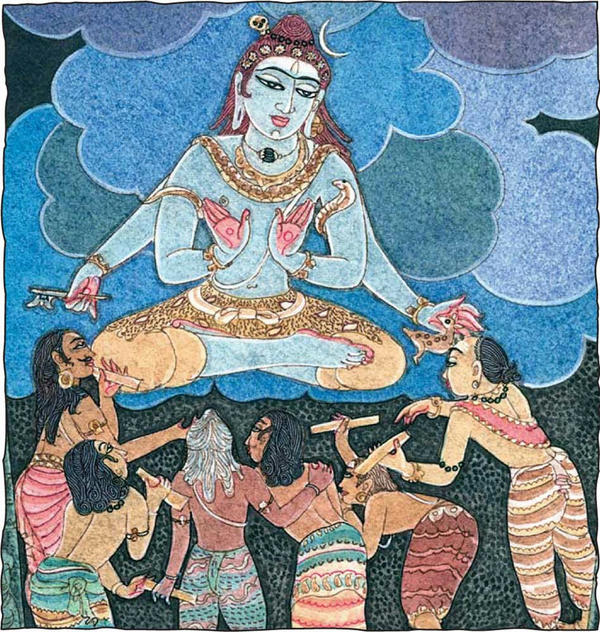7. Writing Prayers Sadhana
The writing of prayers can be done in several ways. Each devotee can write his or her own prayer about personal questions, needs or problems. One can pray for another person, for a group of people, or for a situation to clear up within a group or community, even for solutions to national or world problems. Every prayer received is answered in some way, however mysterious. Not one is neglected, ever. §
The Gods and devas look very carefully into the karma of the devotee before taking any action. Because of this, it is always best to describe two or more alternatives that you would be satisfied with in each prayer, rather than insisting on only one solution. This is because your first preference may not be possible in your karmic pattern or, without your knowing, it may actually be the worst possible thing that could happen to you. In this case, your prayer would be answered with a non-answer. Therefore, it is wise to suggest two or more alternatives when making a request. For example, in seeking help in finding employment, you might suggest three places you would be content at, indicating first choice, second and third.§
We are reminded not to ask for services that the devas would normally provide, such as “Please help me,” or “Please bless me, devas.” These services are automatically performed by the guardian devas of each devout individual without asking.§

There is a time delay of seventy-two hours from when the devas in the antarloka respond to your prayer and when that response manifests in the bhuloka. Therefore, when your prayer relates to a specific event, be sure to pray at least three days before the event will happen.§

It is important the prayer be legible in the inner worlds. Typewritten prayers ( on one side of the page) in English or any language are acceptable to the devas, as are hand-printed prayers that are written with well-rounded, clearly formed letters. If you prefer, prayers can be hand written or typed in the Tyaef script. Typed documents—again on one side of the page only—are acceptable and easily read in the inner world, as long as the size of the type is not too small. Be sure to sign the prayer and also include the date. §
Quote from Gurudeva §
The Gods, their devas and your own guardian devas are ever ready to respond to requests for help and guidance.§
Supplementary Reading§
Living with Śiva, Lesson 316: The Boon of Prayer Writing§
Shortly after the Kadavul Nataraja Deity arrived from India at Kauai Aadheenam, our monastery-temple complex on the Garden Island of Kauai, we received the wonderful boon of communicating with the inner worlds through written prayers. With this six-foot-tall bronze image of the Lord of Dance came tens of thousands of devas. It was revealed to us that these devonic helpers, though unseen to the physical eyes, are skilled in the art of fulfilling prayers. We were delighted to know that written prayers could be offered into their hands through the sacred fire that burns perpetually at Lord Nataraja’s holy feet. In those early days of the beginning of the first Śiva temple in the United States, we felt blessed that this magical boon had come to us. Written prayers were offered up through the sacred temple fire and soon answered. The faith began to build among the devotees. The temple yantra was now fully activated. §
But there was a problem. Sometimes, in devotees’ emotional fervor, prayers were hastily scribbled out and could not be easily read. Seekers assumed that their requests and pleas for help or solace would be known by the Gods and devas who know them personally, and therefore they were not careful enough in composing their prayers, some even forgetting to sign their name or note the date. We soon learned that if prayers were not answered, it might be simply due to incompleteness or illegibility. We also became aware that sufficient explanation must be given for the inner-plane helpers to provide adequate assistance. §

Here is why absolute clarity is necessary in each written prayer. The astral image of each prayer that arrives in the Second World, or astral plane, is an exact duplicate of its physical-plane counterpart, but not quite as clear—more like a carbon copy. So if the physical-plane original is not clear, its astral counterpart will be even less clear. It will be blurred, like trying to read a letter without one’s eyeglasses. Even the astral counterparts of typewritten documents prepared in small type are difficult to read in the inner worlds, we were told. §

To solve the problem of illegibility, the devas themselves gave a new script, which came through from the inner sky in Paris in the early ‘70s. The devas called this script Tyeif. It is designed to look like bamboo leaves, arranged in an intricate pattern to form 135 characters or “images,” the first twenty-six of which correspond to the English alphabet. Here is the word Tyeif written in the devas’ script: tyeif §
Writing and delivering prayers to the Devaloka through the sacred fire is an ancient Natha Sampradaya practice. Today this method of communication is still employed in Shinto and Taoist temples in Japan, China, Singapore, Malaysia and other areas of Southeast Asia. The prayers are written down and placed in the temple fire. As the paper burns, the astral double of the prayer appears in the Devaloka. The prayer is then read by the devas, who proceed to carry out the devotee’s requests. These temple devas are fully dedicated to assist all who come through the temple doors with their emotional, mental and physical problems. §
It was made very clear to me, however, that prayers may only be sent to the Devaloka in a sanctified havana kunda where special arrangements have been made with the devas.§
Additional Resources§
Living with Śiva, Chapter 46: Sending Prayers to the Gods§
